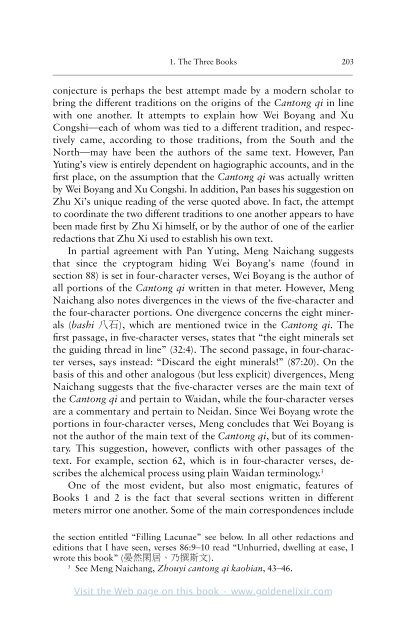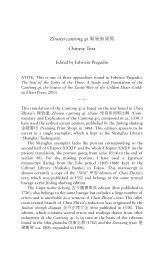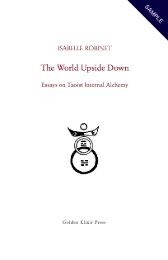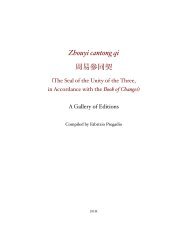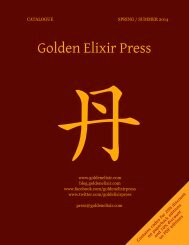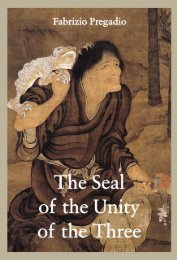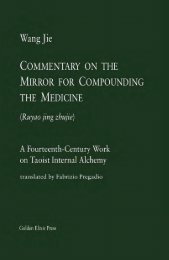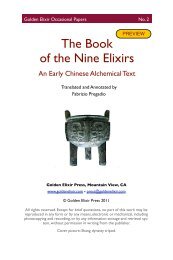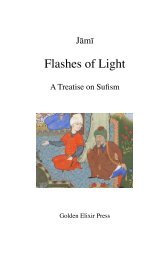The Seal of the Unity of the Three â Vol. 2 - The Golden Elixir
The Seal of the Unity of the Three â Vol. 2 - The Golden Elixir
The Seal of the Unity of the Three â Vol. 2 - The Golden Elixir
- No tags were found...
Create successful ePaper yourself
Turn your PDF publications into a flip-book with our unique Google optimized e-Paper software.
1. <strong>The</strong> <strong>Three</strong> Books 203<br />
—————————————————————————————————————————<br />
conjecture is perhaps <strong>the</strong> best attempt made by a modern scholar to<br />
bring <strong>the</strong> different traditions on <strong>the</strong> origins <strong>of</strong> <strong>the</strong> Cantong qi in line<br />
with one ano<strong>the</strong>r. It attempts to explain how Wei Boyang and Xu<br />
Congshi—each <strong>of</strong> whom was tied to a different tradition, and respectively<br />
came, according to those traditions, from <strong>the</strong> South and <strong>the</strong><br />
North—may have been <strong>the</strong> authors <strong>of</strong> <strong>the</strong> same text. However, Pan<br />
Yuting’s view is entirely dependent on hagiographic accounts, and in <strong>the</strong><br />
first place, on <strong>the</strong> assumption that <strong>the</strong> Cantong qi was actually written<br />
by Wei Boyang and Xu Congshi. In addition, Pan bases his suggestion on<br />
Zhu Xi’s unique reading <strong>of</strong> <strong>the</strong> verse quoted above. In fact, <strong>the</strong> attempt<br />
to coordinate <strong>the</strong> two different traditions to one ano<strong>the</strong>r appears to have<br />
been made first by Zhu Xi himself, or by <strong>the</strong> author <strong>of</strong> one <strong>of</strong> <strong>the</strong> earlier<br />
redactions that Zhu Xi used to establish his own text.<br />
In partial agreement with Pan Yuting, Meng Naichang suggests<br />
that since <strong>the</strong> cryptogram hiding Wei Boyang’s name (found in<br />
section 88) is set in four-character verses, Wei Boyang is <strong>the</strong> author <strong>of</strong><br />
all portions <strong>of</strong> <strong>the</strong> Cantong qi written in that meter. However, Meng<br />
Naichang also notes divergences in <strong>the</strong> views <strong>of</strong> <strong>the</strong> five-character and<br />
<strong>the</strong> four-character portions. One divergence concerns <strong>the</strong> eight minerals<br />
(bashi 八 石 ), which are mentioned twice in <strong>the</strong> Cantong qi. <strong>The</strong><br />
first passage, in five-character verses, states that “<strong>the</strong> eight minerals set<br />
<strong>the</strong> guiding thread in line” (32:4). <strong>The</strong> second passage, in four-character<br />
verses, says instead: “Discard <strong>the</strong> eight minerals!” (87:20). On <strong>the</strong><br />
basis <strong>of</strong> this and o<strong>the</strong>r analogous (but less explicit) divergences, Meng<br />
Naichang suggests that <strong>the</strong> five-character verses are <strong>the</strong> main text <strong>of</strong><br />
<strong>the</strong> Cantong qi and pertain to Waidan, while <strong>the</strong> four-character verses<br />
are a commentary and pertain to Neidan. Since Wei Boyang wrote <strong>the</strong><br />
portions in four-character verses, Meng concludes that Wei Boyang is<br />
not <strong>the</strong> author <strong>of</strong> <strong>the</strong> main text <strong>of</strong> <strong>the</strong> Cantong qi, but <strong>of</strong> its commentary.<br />
This suggestion, however, conflicts with o<strong>the</strong>r passages <strong>of</strong> <strong>the</strong><br />
text. For example, section 62, which is in four-character verses, describes<br />
<strong>the</strong> alchemical process using plain Waidan terminology. 3<br />
One <strong>of</strong> <strong>the</strong> most evident, but also most enigmatic, features <strong>of</strong><br />
Books 1 and 2 is <strong>the</strong> fact that several sections written in different<br />
meters mirror one ano<strong>the</strong>r. Some <strong>of</strong> <strong>the</strong> main correspondences include<br />
<strong>the</strong> section entitled “Filling Lacunae” see below. In all o<strong>the</strong>r redactions and<br />
editions that I have seen, verses 86:9–10 read “Unhurried, dwelling at ease, I<br />
wrote this book” ( 晏 然 閑 居 、 乃 撰 斯 文 ).<br />
3<br />
See Meng Naichang, Zhouyi cantong qi kaobian, 43–46.<br />
Visit <strong>the</strong> Web page on this book • www.goldenelixir.com


